By C. Todd Lopez
KWAJALEIN, Republic of the Marshall Islands (March 01, 2011) -- There are about 1,200 Americans living on Kwajalein, but they are not alone in the atoll. Less than 2 miles north of Kwajalein Island is Ebeye Island, where some 15,000 Marshallese live.
And like all U.S. military installations, the Army wants to have a great relationship with the citizens of the host nation.
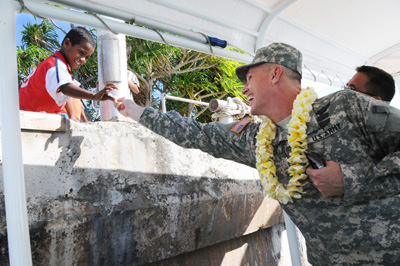
"We do a lot of things in terms of being good neighbors," said Col. Joseph N. Gaines, commander, U.S. Army Kwajalein Atoll. "For instance, we had a call saying there was a Marshallese boat missing, and they wanted us to assist in search and rescue."
In early 2009, when a Marshallese civilian was bitten by a shark, leadership at USAKA provided assistance.
"We flew a helicopter up there and flew him back to Ebeye," Gaines said. "We saved his life -- we do a lot of good neighbor things."
In the fall of 2010, USAKA provided another kind of help. About 40,000 gallons of water was taken via barge from Kwajalein to the nearby island of Ebeye as part of a relief effort when that island's water supply system failed. With a failed water purification system, islanders were left with just a four-day supply of water; the Army stepped in to help.
"Some of the units were having a problem, so they were unable to generate fresh water for the population over there," said Gaines. "We stand ready to support our neighbors in Ebeye, especially when there is a health, life or safety issue."
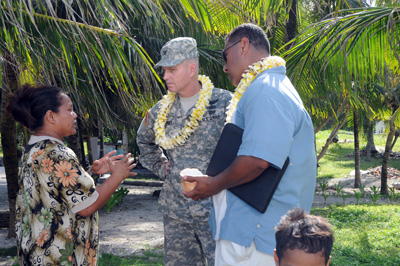
Gaines turned to his director of logistics, Capt. Michael Quigley, to help with the water issue on Ebeye. The captain sent a reconnaissance team to the island to assess the state of its water supply system. Ultimately, some repair work had to be done to fix supply lines on the island before fresh water could be brought in.
By evening, a water barge travelled the short distance from Kwajalein to Ebeye, and once there, the fresh water was pumped into the island's water system. Quigley said providing such support to the Marshallese is something he, as a logistics officer, is expected to know how to do.
"It is one of the aspects of full-spectrum operations," he said. "Coming from two tours in Iraq, doing multiple things, including both transportation and some humanitarian support, you are kind of expected as a logistics officer to keep that in your back pocket -- being able to pull that out when you need it."
About 1,000 Marshallese come from Ebeye to Kwajalein each day, where they work in a variety of jobs.
"We have two Marshallese pilots that fly the airplanes," Gaines said. "And we have Marshallese that work on the jet engines. We also have Marshallese in Roi-Namur that are working the technical aspects of the radar. So they run the gamut from picking up coconuts out here to flying our airplanes."
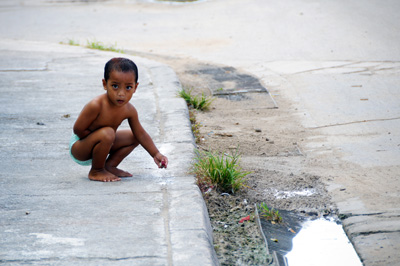
As part of the good neighbor policy with the Marshallese in the atoll, young people from Ebeye are invited at an early age to apply to attend the American school on Kwajalein. Each year about five are accepted to attend school there, beginning in kindergarten, said Al Robinson, principal and superintendent of the schools on Kwajalein.
"Then they have access to our school through high school," he said.
There are about 7,000 children on Ebeye under age 18, and only schools for about 3,400-3,500. The island itself is only about .13 square miles, making Ebeye -- with a population density of about 107,000 per square mile -- one of the most densely populated places on earth.
The U.S. has had a relationship with the Marshallese since Kwajalein Atoll was taken from the Japanese in February 1944, during Operation Flintlock -- part of America's Pacific campaign in World War II.
"This was a U.S. trust territory, and we took care of these folks until 1986, and then it became a sovereign nation," said Gaines.
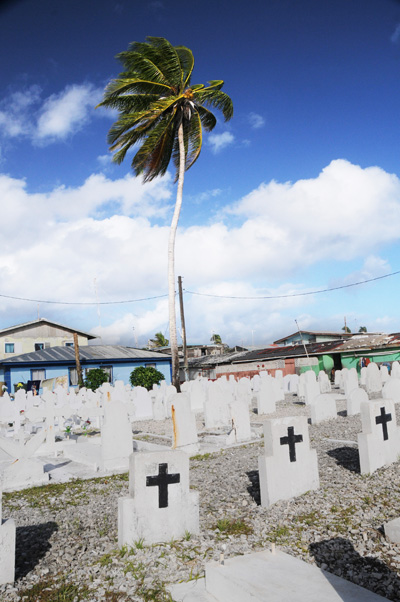
Since then, the colonel said, the nation has been struggling to emerge as a democracy. But today, the U.S. and the Republic of the Marshall Islands enjoy a unique relationship in that they are signers to a Compact of Free Association. The Compact provides special privileges to Marshallese that citizens of other nations do not have.
"The citizens may go to the United States, study, work and live without a visa. That's pretty unique in the world," said ambassador to the RMI, Martha L. Campbell. "Also, we give about $60 million a year in direct Compact funding. Plus, they have access to a lot of U.S. domestic programs to which other countries don't have access."
Some of those programs include Health and Human Services, the Department of Agriculture, the Department of Energy, and the National Oceanic and Atmospheric Administration.
Among the highest priorities for both the U.S. and the RMI is health and education in the island nation, Campbell said.
"A lot of the Compact funding goes to those two things, and we are always trying to encourage them to look for best ways on how to use that and make the education system better," she said.
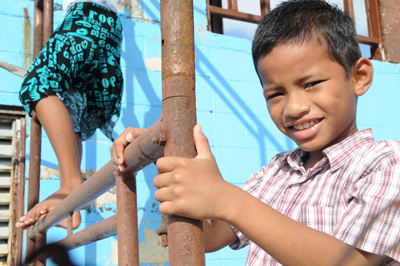
Campbell said the Marshallese have done a good job building new schools with money from the Compact. Almost 200 classrooms have been built across the RMI over the past few years, including an eight-room elementary school that just opened in nearby Alinglaplap.
One of the biggest challenges in the RMI is helping the nation become economically self-sufficient. There are about 60,000 citizens throughout the Marshalls, and the largest employer of those citizens is the government of the Marshall Islands. The second largest employer is USAKA.
Campbell said the Marshallese do have a fledgling fishing industry, and there's a potential for tourism, although the islands are distant from population centers, and promoting tourism may prove challenging. Now, she said, byproducts from coconut harvesting, called copra, fuel trade on the islands.
"Most of these islands, what they do to pay for a living is gathering copra, which is a coconut byproduct," Campbell said. "They process it and get it ready and wait for the ship to come."
Copra can be used to make oils, and Campbell said there's a study being funded to see if that oil can be used for fuel. Availability and cost of fuel is also a problem for RMI, as is transportation.
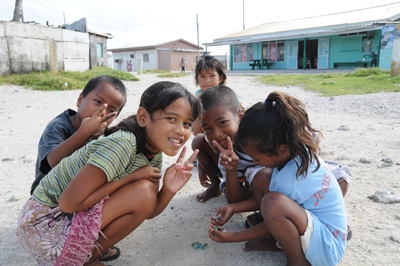
The ambassador also said that climate change is another concern.
"It doesn't take very much to make them disappear. The high point on Majuro (the capital of the Marshall Islands) is 10 feet above sea level, and that's the top of the bridge connecting two islands," Campbell said. "We are supporting a lot of disaster preparedness planning for the Marshall Islands."
She said the RMI government is working to develop plans with the U.S. Federal Emergency Management Agency as well as with the U.S. Office of Foreign Disaster Assistance, part of the U.S. Agency for International Development.
Despite problems in the RMI, the nation remains an important ally to the defense of the U.S., said Campbell, due in part to its strategic position in the Pacific and to the Ronald Reagan Ballistic Missile Defense Test Site located there.
Gaines said as commander at USAKA, he intends to maintain a "good neighbor" policy, in part, because of the importance the Marshallese play in keeping his installation operating.
"A good portion of our work force comes from Ebeye and they are an important part of our community -- both the work force and the Marshallese people," Gaines said. "So from my perspective, as a commander, any time they need our help, we are going to step in."